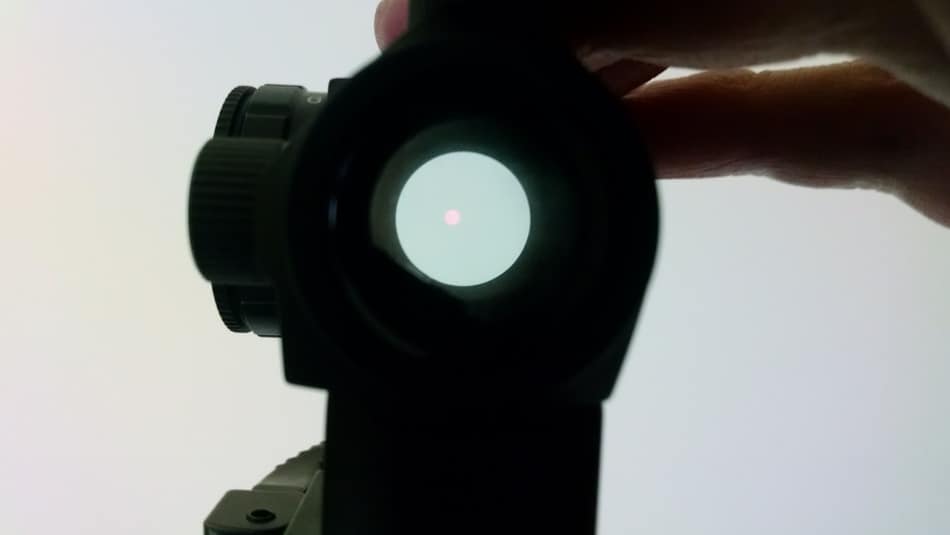You probably have heard of a red dot scope (reflex sight) before. The real name is reflex sight but there are different types. Red dot is the most common used name. Colors and shape of reticle can be different depending on the brand and model.
When I purchased my Bushmaster AR-15 it included a mini red dot sight RT5, so I didn’t have to shop separately for one. It wasn’t until later did I find out that there was different types of red dot sights and a lot more to the common optic.
So if you are either shopping for a red dot scope or just experimenting with one you own already then you may want to level up your knowledge a bit on red dots and reflex optics.
I will use the terms scope and sight and optics interchangeably throughout but I mean the same thing.
Red Dot scopes are non-magnifying sights that are used for rifles, handguns and shotguns. Red dot optics are best for quick target acquisition. They can be used for basic target shooting or even hunting. Even though they don’t allow magnification red dots offer greater advantages to stock iron sights.
How far is red dot accuracy? Red dot optics are best sighted in at 100 yards. Accuracy after 100 yards depends on the size of the target and scope design. Because red dots are non-magnifying scopes they are used for mid-range shooting. Red dot accuracy range is dependent on user’s skill and firearm being used.
Red dots really show their strength with speed shooting and during close-quarters battle (C.Q.B.) either in warfare or sport.
Types of red dot reflex gun sights:
- Open Reflex
- Tube Reflex
Open Reflex vs Tube: Pros & Con’s
These two types of reflex sights are both called red dot scopes.
Open/exposed reflex sight looks similar to a single window. There is one lens that is square shaped and thin. Like a laptop screen almost. When someone thinks of red dot scope they are most likely thinking of open reflex sight.
Tube sight has a cylindrical shape. It is more like a scope and is longer in length.
Open or exposed reflex sights are the easiest to acquire a target the fastest. This is because of not having to look down the tube.
Tube scope types can be easier to use in bright conditions because the dot is shaded within the tube. Tube scopes can be more durable than open sights. They can also be heavier than open.
Different firearms work better for each type. Open reflex sights works better than tubed on a pistol. Rifles and shotguns can use either one based on preference.
| Two Types | Pros: | Cons: |
| Tube | Longer Distances, Durable | Bulkier |
| Open | Faster targeting, Lighter, smaller | Break Easier |
How Red Dots Scopes Work
Red dot sights have a LED light inside that operates off a small battery. Unlike a laser sight red dots actually point the light towards the shooters eye. The dot is used as a focal point in the lens to use for targeting. Most red dot scopes have switches/dials (rheostat) or a button that adjusts the brightness of the dot.

What To Look For In a Red Dot Sight
When deciding on which reflex red dot sight to pick consider these factors.
- Co-witnessing Compatibility
- Battery Life
- Durability
- Reticle type and shape
- Activation
- Mounting Hardware
- Reflex sights that allow for co-witnessing. This means that iron sights can still be used in conjunction with red dot. In case red dot malfunctions back up iron sights are still readily available. Some reflex sights take up too much space on mounting rail, blocking any extra room for iron sights. Flip up iron sights might also not align or fit with certain reflex sights.
- Battery life: Leaving a reflex sight on for extended time has many benefits especially for military. Recreational shooters can still benefit from long battery life. Batteries are expensive and the more efficient the better. Extra batteries are easy to have ready for targeting shooting, but a firearm for home-defense or in time of need the battery life becomes more important.
- Durability goes along with how well the red dot holds up. If using a red dot for a hunting firearm, you want one that can withstand the elements and any abuse. Same can be said with competition shooting and recreation. Consider if you are going to be shooting in extreme heat or cold or in the rain/snow. A well built reflex sight will last longer and is a better investment.
- Red dots commonly have a single dot as a reticle. Think about if you want one with a different shape. Whichever you find most comfortable using. Also if you want the ability to change the color. Multi color options are good for hunting. This is because some colors are better contrasted in different hunting situations.
- Activation: How the reflex red dot sight is turned on or off. More importantly turned on. Some use a button some have a switch. Some are motion censored and others the on/off switch can be mounted on the hand guard (with rifles). This is important for close-quarters combat (C.Q.B.) but also home-defense.
- Mounting hardware: A reflex sight can use a simple locking lever (quick release) to be easily attached and removed from rail mount. Some red dots have screw mounts and require a tool or shell to remove. The tool can be lost or cause stripping, it also takes longer to attach or detach scope.
Field of view (FOV) is something that many shooters take into account with reflex sights. A reflex sight with a greater field of view is considered better. It is not something I put on the list but is good to know about.
Other features:
- Fog-proof: Nitrogen gas is used inside of scope to prevent fogging on lens due to temperature changes or humidity.
- Brightness Settings: Number of brightness levels the scope can be set to.
- MOTAC (Motion Activated Illumination): Red dot sight powers on when motion is detected and automatically turns off when idle.
- Waterproofing: Rainproof and some are even submersible.
- Illumination memory: Saves the last brightness intensity for returning user.
Here is the best red dot sights on Amazon if you are interested.
My Favorite Red Dot Site
Its hard to beat the Bushnell Trophy, this red dot sight is what I would recommend. Check it out on Amazon here.
Why Use A Red Dot?
Although less precision at longer distances than a telescopic sight. Red dots are easier than iron sights to use and are very intuitive. Another reason is the cost of a red dot vs other scopes. Red dots can be more affordable making them an inexpensive upgrade to a gun.
They are also faster for acquiring a target. This is true for many scenarios, home-defense or on the range. As mentioned earlier some reflex sights have auto on feature that works with motion detection. When the scope detects movement it turns on automatically. This is a great feature that shaves off time that could be vital for many situations.
Using a red dot is great for short range target shooting with a rifle and for competition shooting where speed is required.
Pistol mounted micro red dots improve accuracy.
What Is MOA On A Red Dot Scope?
The description for many red dot scopes list 2 or 4 MOA. While shopping for red dots you will come across this and may wonder what MOA means.
MOA is used for describing the click value for sighting windage and elevation. It also is used for the size of the red dot. MOA stands for minute of angle, 2 MOA at 100 yards equals 2 inch. A red dot scope with 4 MOA will mean at 100 yards the red dot covers 4 inches.
Windage is for horizontal sighting and elevation is for vertical.
A scope with 2 MOA works better for smaller targets at 100 yards. This is because your dot (given that it is sighted in precisely) will cover 2 inches diameter of a target. A 2 MOA at 300 yards grows to 6 inch diameter and so on.
With 4 MOA, at 100 yards your dot is a 4 inches. At 300 yards the dot becomes a 16 inch circle. Making it harder to hit smaller targets, because the dot is so large it will cover up the target.
Example: Say you are shooting at 3 pop cans side by side at 100 yards. which sight would allow you shoot at individual cans easier? The 2 MOA dot will cover 2 inches at 100 yards. This size is good for a pop can because it is roughly the same size. A 6 MOA dot at 100 yards will cover the can and even the one next to it. Making it harder to hit one single can because the dot is larger.
The farther away a target moves the smaller it becomes. The dot on your scope never changes so the accuracy decreases. This is why the MOA is important.
Choosing The Right MOA
The choice of which MOA doesn’t matter as much if you are going to be using the scope at a 100 yard gun range. Because at 100 yards 2 MOA and 4 MOA are not much different. Only a couple inches, but for farther yardage it does start to make a bigger difference.
Using a red dot for a home defense go with the larger 4 or 6 MOA, because aiming within 100 yards you want the dot to be easier to see. The dot on a 2 MOA is going to appear small relative to the target requiring more focus to aim.
If you have a 2 MOA red dot and use the gun for home defense brighten the dot to make it easier to sight quickly.
Dot Size MOA:
- 1-2 MOA Dot Size= Better for longer distance accuracy.
- 4-6 MOA Dot Size= faster aiming at less distance.
Click Value MOA:
- 1 MOA: Most common click value. 1 click equals 1 inch.
- .5 MOA: High end scopes for more accurate sighting. 1/2 inch click equals 1/2 inch.
Red Dot Tips and Conclusion:
- Increased brightness of red dot uses up more battery.
- Windage adjusts bullet projection horizontally.
- Elevation adjusts bullet projection vertically.
- Two types of red dot scopes tube and open.
- Red dots describe a type of reflex scope.
- Can be used for pistol, shotgun and rifle.

